The 5 Best Audio Interfaces for Guitar – Our Top Picks
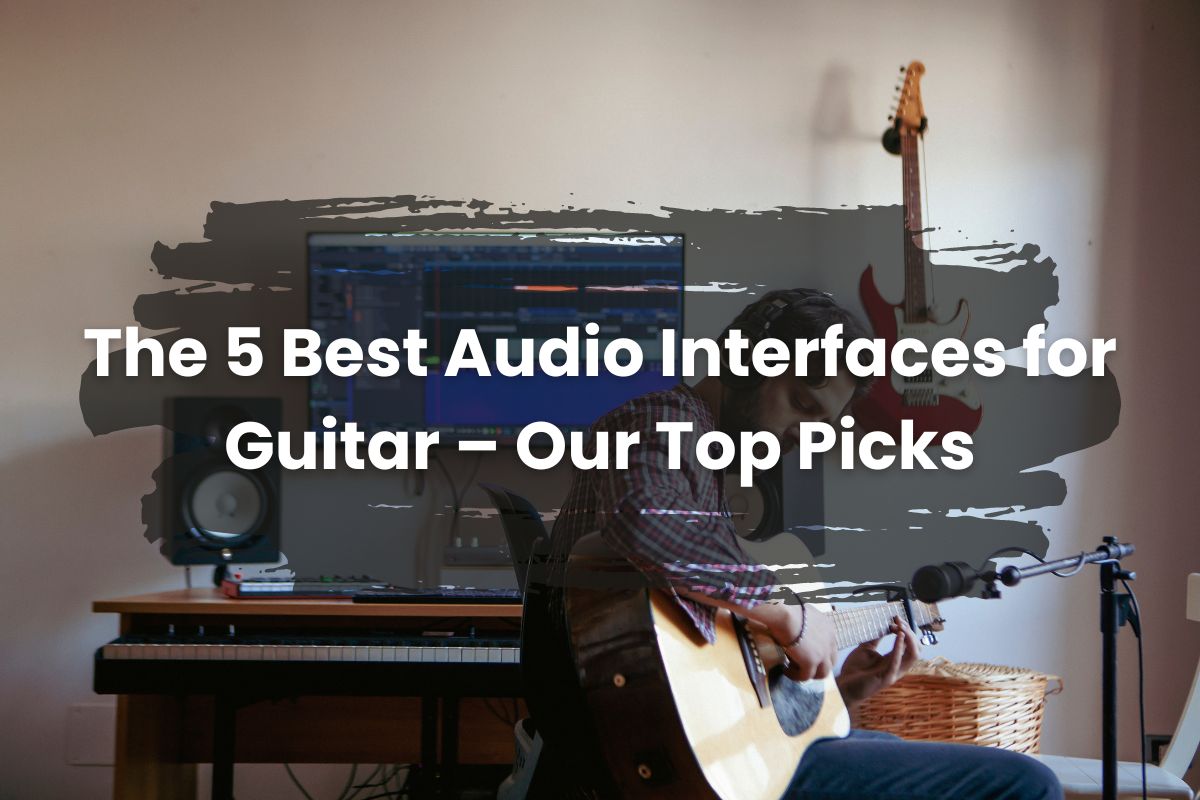
An audio interface is a vital tool to have when recording a guitar digitally. They are a bridge between your guitar and the computer. Although you can technically plug a guitar directly into a sound card, using an audio interface ensures the guitar’s true sound is projected.
They convert the analog signal from a guitar to digital data for the computer to process. If you plan to get a professional quality sound, you have to invest in an audio interface. With this device, you can monitor and control audio levels, add effects, and add various mixers.
When looking for one, you may be confused by the sheer choices you have. So let’s narrow down these choices to the 5 best audio interfaces for guitar.
We have taken the time to test them out and give you our honest opinion on why we chose them. So without much further ado let’s get started.
Key Takeaways: 5 Best Audio Interfaces For Guitar
- Focusrite Scarlett 2i2: Great for Professionals
- Universal Audio Apollo Twin MKII: Great Software support
- PreSonus AudioBox USB 96: Budget oriented with good sound
- Native Instruments Komplete Audio 2: Great for Mid-level musicians
- Behringer UMC22: Great for first-time users
5 Best Audio Interfaces For Guitar
Here are our top picks of the best audio interfaces for recording guitars.
1. Focusrite Scarlett 2i2
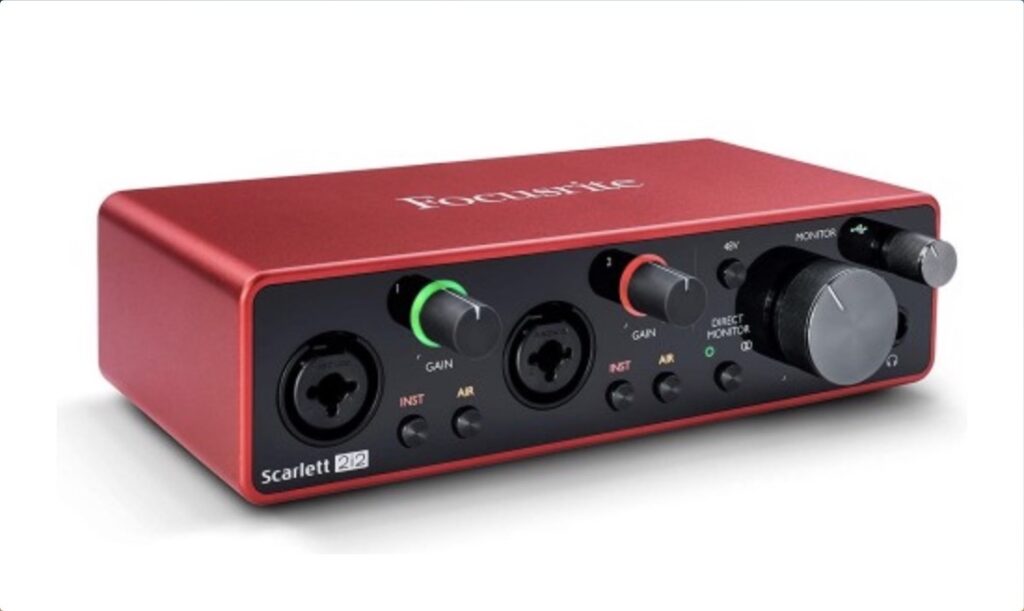
Focusrite has been in the market for almost a decade now. Their Scarlett 2i2 is loved for its simplicity and is great for beginners. It runs on a USB and features two inputs and two outputs with combo XLR/¼-inch input jacks.
You get a line/instrument level switch and an Air mode with each input. This enhances high-end details and gives you a sense of space. The Scarlett 2i2 also supports 24-bit/192kHz converters so that you get the best sound.
To minimize latency, you get a USB-C port that makes latency almost invisible. Low latency is essential for real-time monitoring without delays. The interface also offers phantom power and a direct monitoring switch, making it versatile for various recording needs.
The Scarlett 2i2 is our top pick because it gives you almost everything you need. You get great sound quality through the high-grade preamps and the special Air mode. Additionally, it is finished with a solid build making it reliable for both recording in a studio and on the go.
Pros
- High-quality preamps to ensure a clean sound.
- The special Air mode feature improves clarity and detail
- Very low latency.
- Solid build quality
- User-friendly design.
Cons
- No MIDI I/O connectivity
2. Universal Audio Apollo Twin MKII
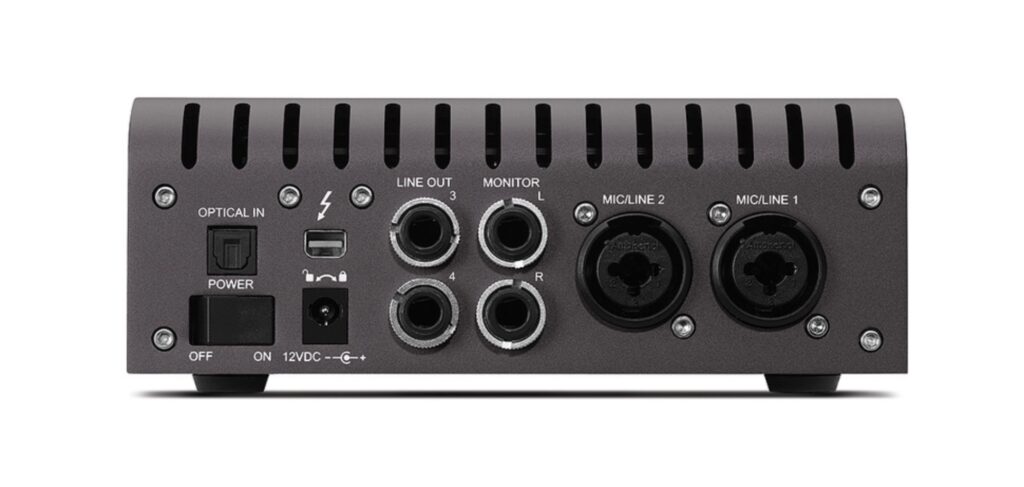
Second in line is the Universal Audio Apollo Twin MKII with its features geared towards professional musicians and audio engineers. The MKII has two Unison-enabled mic preamps that let you record the emulation of classic preamps. This is great because you can get the sound of vintage gear without actually having to own one.
You get a built-in DSP that allows for real-time processing with UAD plug-ins. This minimizes latency and puts less pressure on your computer’s CPU. If you tend to use multiple effects at a time, the MKII can handle it. Additionally, the MKII supports up to 24-bit/192kHz so that you get nothing but the best audio reproduction.
What’s unique about the MKII are the Unison preamps. You can emulate the tone of a classic tube of solid-state preamps through one device. Latency is kept at a minimum important to keep everything in order during a session. Finally, with a solid build quality, you get the option of using the MKII as a part of a much larger setup, if you need it.
Pros
- Great sound quality from AD/DA converters.
- Unique Unison technology emulates the sound of classic preamps.
- Real-time processing from the Built-in DSP
- Has a built-in talkback and speaker-switching feature.
Cons
- Thunderbolt cable needs to be bought separately.
- Preamp settings cannot be controlled on cascaded Apollo systems.
3. PreSonus AudioBox USB 96
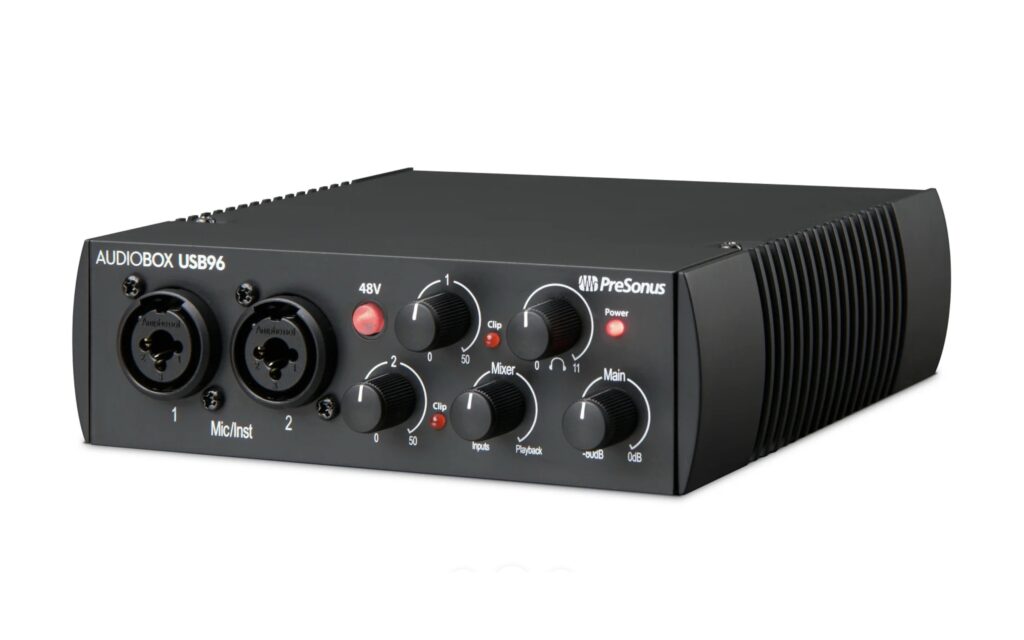
If you are in the beginner group of the market, the PreSonus AudioBox USB 96 can be a great option to look into. It is affordable and compact making it great for home studios. It supports 24-bit/96 kHz audio resolution that is good enough for home use. It comes paired with the Studio One Artist software that complements the hardware for those new to an all-digital workstation.
You get two combo XLR/TRS inputs equipped with high-quality Class-A mic preamps. It is powered by a 48V phantom power supply that supports using condenser microphones. It also comes fitted with a zero latency mixer knob to lend direct input and playback. Although more on the budget side of things, it does a great job at keeping latency low.
We recommend this interface for those looking for a simple straightforward solution. You get clean preamps that will do the job of sounding great. It is a great device to have for beginners as it is simple and a great starter interface.
Pros
- Affordable entry into audio interfaces.
- Solid build and compact
- The Studio One Artist software is a great tool to have for beginners.
Cons
- It does not have the latest and greatest sound quality, limited to 24-bit/96 kHz.
- Preamps may not be the best for dynamic microphones.
4. Native Instruments Komplete Audio 2
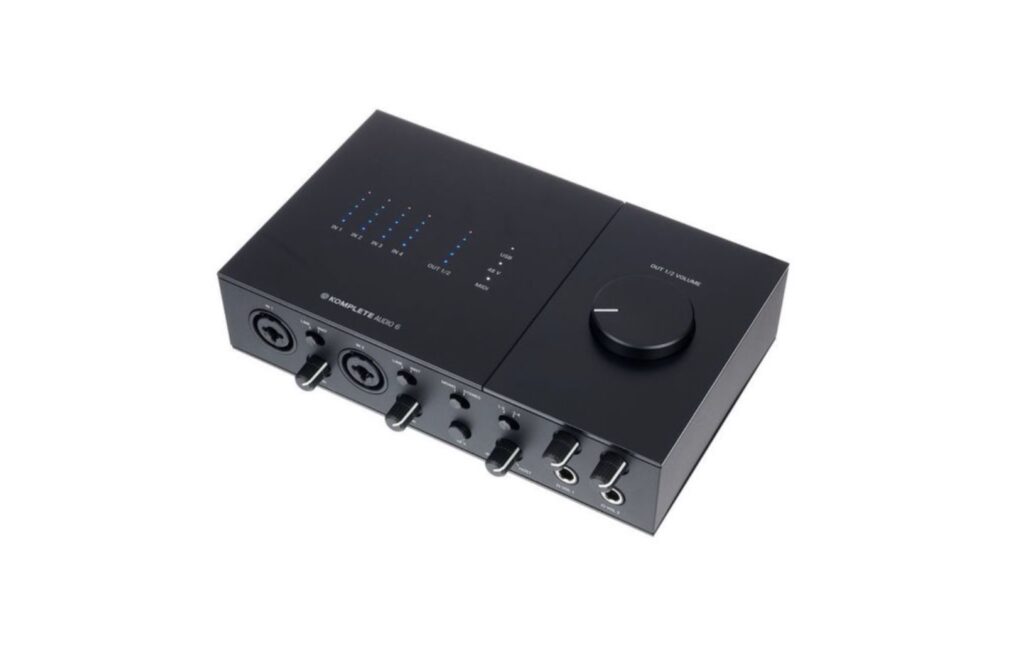
If you are looking for an even more compact audio interface, check out the Native Instruments Komplete Audio 2. For its size, it packs a punch with its 2-in/2-out setup. You get two combo XLR/1/4″ inputs with individual selector switches. Additionally, you get a 48V phantom power supply and hi-res audio of 24-bit / 192 kHz.
For beginners, this is a more mid-level interface to check out for its user-friendly design. The outlook is finished with a large level knob and an independent headphone level control. You can find a balance knob on the front panel that can be used to blend inputs.
What’s great about the Komplete Audio 2 is the bundled Guitar Rig 6 LE software. Through this software, you get access to various amp simulations and effects. Together with its compact size and easy setup, it is a great audio interface for musicians on the go.
Pros
- The compact design is great for musicians on the go.
- High-quality preamps
- High-resolution audio support of up to 24-bit / 192 kHz.
- Comes with a great software bundle package.
Cons
- Build quality in comparison to others is plasticky
- No MIDI I/O inputs
5. Behringer UMC22
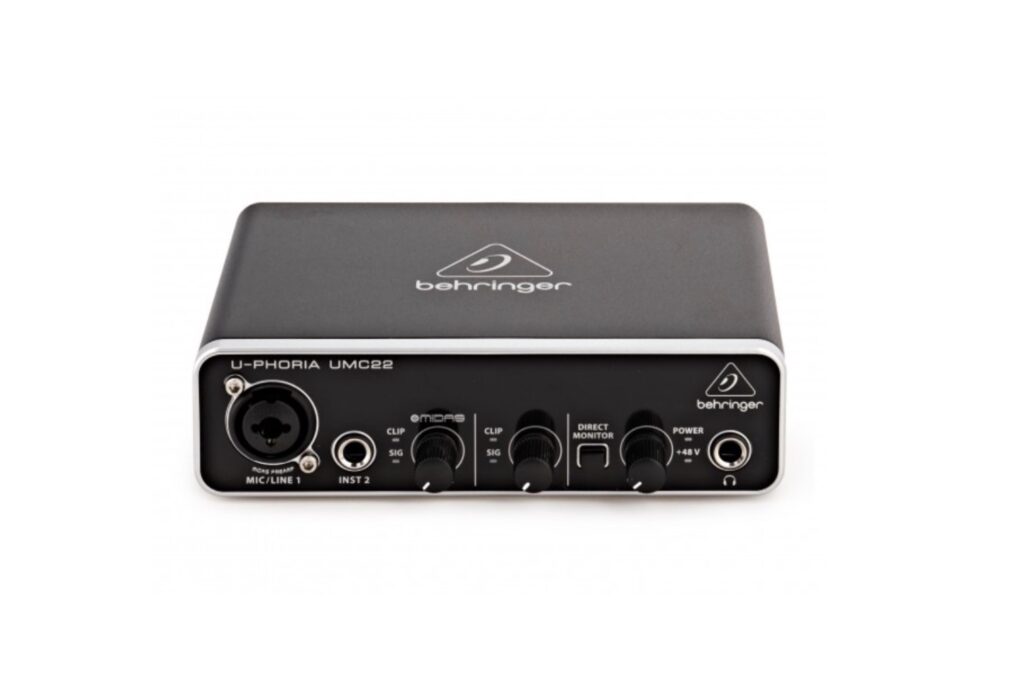
Behringer is another name that has been in the game for a long time. Their UMC22 is one of the more affordable interfaces you can pick up. Aimed at true beginners, this interface cuts many corners to be a true entry-level device. You get a compact USB audio interface that features a MIDAS-designed preamp. It can deliver signals of up to a modest 48kHx of audio resolution.
You get the basic combination of XLR/TRS input for microphones or line-level devices, and a 1/4″ instrument input. One great thing is that it includes a phantom power for condenser microphones, something not available in devices in the price category.
What’s great about the Behringer UMC22 is that it is a no-nonsense device that does what it was meant to do well. It is great for beginners simply due to the price and simple features. It is ideal for guitarists looking for an audio interface for home recording.
Pros
- Very affordable
- Comes with MIDAS-designed preamp
- Compact and durable design
- Latency-free direct monitoring capability
Cons
- Limited to 48 kHz audio resolution
- There have been issues with signal noise
Comparing the Top 5 Audio Interfaces
Let’s compare these audio interfaces across a few criteria.
| Feature | Focusrite Scarlett 2i2 | Universal Audio Apollo Twin MKII | PreSonus AudioBox USB 96 | Native Instruments Komplete Audio 2 | Behringer UMC22 |
| Price | Mid-range | Premium | Affordable | Affordable | Entry Level |
| Preamps | High-quality preamps | Unison preamps | Great for the price | Standard clean | MIDAS-designed preamp |
| Latency | Very low | Near-zero | Low | Low | Low |
| Software Bundles | Extensive bundle | Bundled with UAD plugins | Studio One Artist | Maschine Essentials, Ableton Live Lite | Basic |
| User Reviews and Feedback | Highly favorable | Highly praised for quality and features | Generally positive for beginners | Positive and loved for its compactness and software | Mixed review mainly due to basic functionality |
How to Choose the Right Audio Interface for Your Needs?
Before deciding on what audio interface you want you need to classify your needs. Categorize your choices according to the following factors.
Budget Considerations
For beginners, affordable models that offer basic functionality will do just fine. They are cheap and get the job done. Check out brands like Behringer and PreSonus for great entry-level devices. Offer entry-level interfaces that are cost-effective.
If you want to upgrade your existing setup, look into the Focusrite and Universal Audio devices. They have advanced features like multi-track recording and higher audio quality. These are more expensive but make up for it with bundled software to sweeten the deal.
Feature Priorities
Before buying an interface, pen down what you want when connecting to an audio interface.
- Input/Output (I/O) Options: For simple home setups two inputs are good enough. For more complex setups you may need more I/Os.
- Preamps Quality: Beginners do not necessarily need the best to start with. Some interfaces come with a decent preamp that can make up for a lack in other aspects.
- Latency: Look for interfaces that offer direct monitoring to bypass this latency issue.
- Portability: If you are a traveling musician, look for devices that are compact but rich in features.
Compatibility with Your Setup
Make sure the interface you choose is up with the time.
- Computer Compatibility: Check if the interface is compatible with your operating system (Windows or macOS).
- DAW Compatibility: Some can come with specific Digital Audio Workstation (DAW) software that can be an added benefit.
- Connectivity Options: Look for a device that has the latest connectivity options like USB C, Thunderbolt, or FireWire.
Future-proofing Your Investment
To make sure your investment is set to last years, look into interfaces that have additional inputs like ADAT or S/PDIF. This is great if you want to expand your setup in the future. Additionally, look for devices that have a solid build and stay away from those made of plastic. While audio interfaces in general do the same thing, a device from a reputed brand will support updated software for longer.
Frequently Asked Question
An audio interface converts the analog signals from a guitar into digital data that a computer can process. You need one to record high-quality audio onto your computer. It has better control over sound levels and quality in comparison to standard computer sound cards.
Almost all modern audio interfaces are compatible with DAW. With a USB C or Thunderbolt connector, they can be used with software like Ableton Live, Pro Tools, FL Studio, and many more.
To get a complete package, you can add equipment like microphones, durable cables, headphones, and pop filters to your setup.
For live performances, make sure the audio interface you use has low latency with enough input and output ports. It should be a blend of both durability and portability. Interfaces that can run on their own without a computer can be a great option.
To connect your guitar to an audio interface, connect one end of a ¼-inch instrument cable to the guitar and the other to your interface. Make sure to adjust the input gain so that the sound does not clip. It is best to set the interface input to the instrument level rather than the line level for a guitar. If your interface supports it, use direct monitoring to hear yourself play without latency.
Choosing the Perfect Audio Interface For You
We believe that by now it’s established that an audio interface can be beneficial when recording or playing live. We highly recommend the Focusrite Scarlett 2i2 for more professional guitarists and the PreSonus Audiobox USB 96 for beginners.
These devices are very reliable and can be a great addition to most rigs. Be it home studios or more professional ones, you need to make sure the end sound is of the best quality. Buying a good audio interface can be a great investment for the future. So which one are you planning to buy? Let us know in the comments below!
